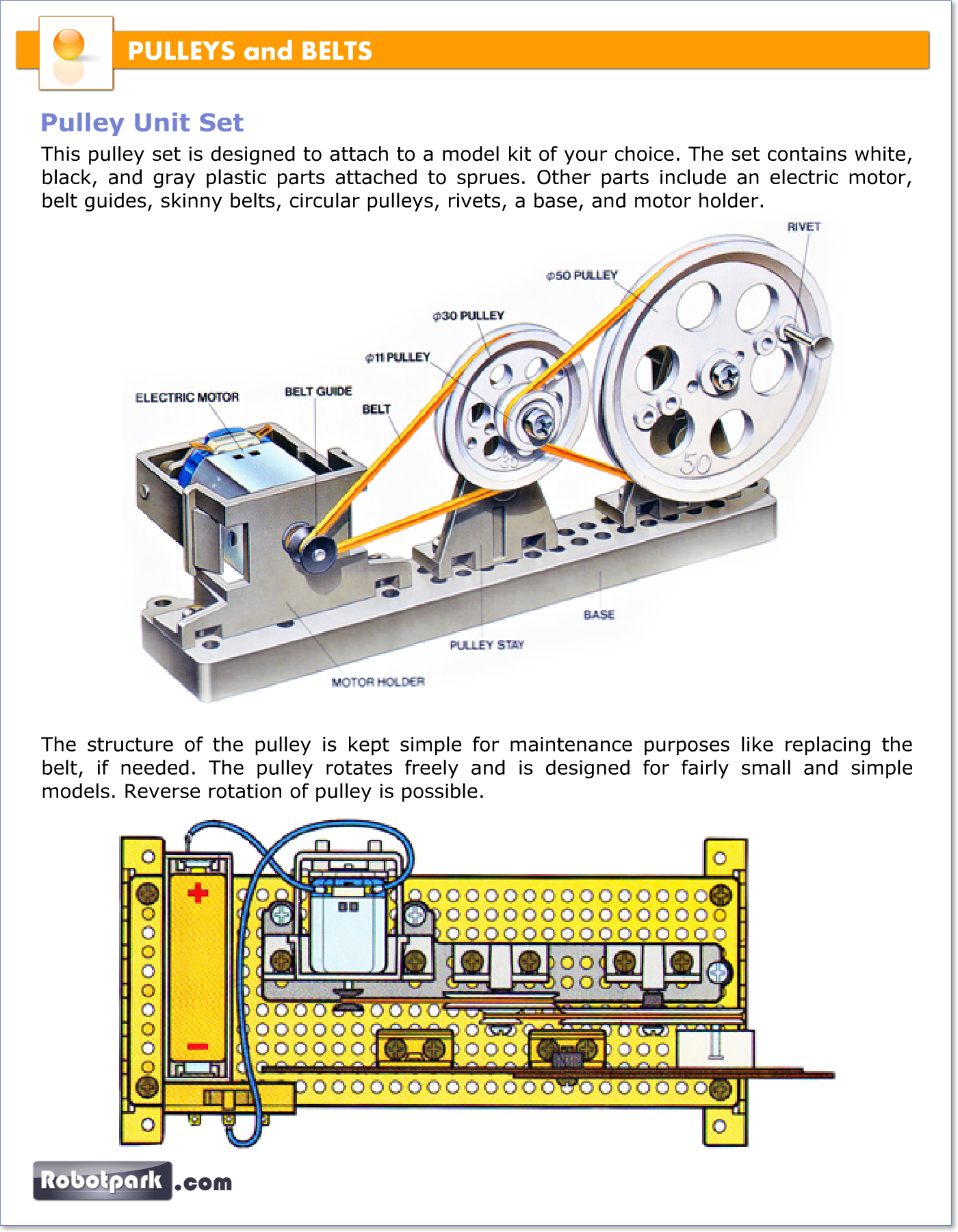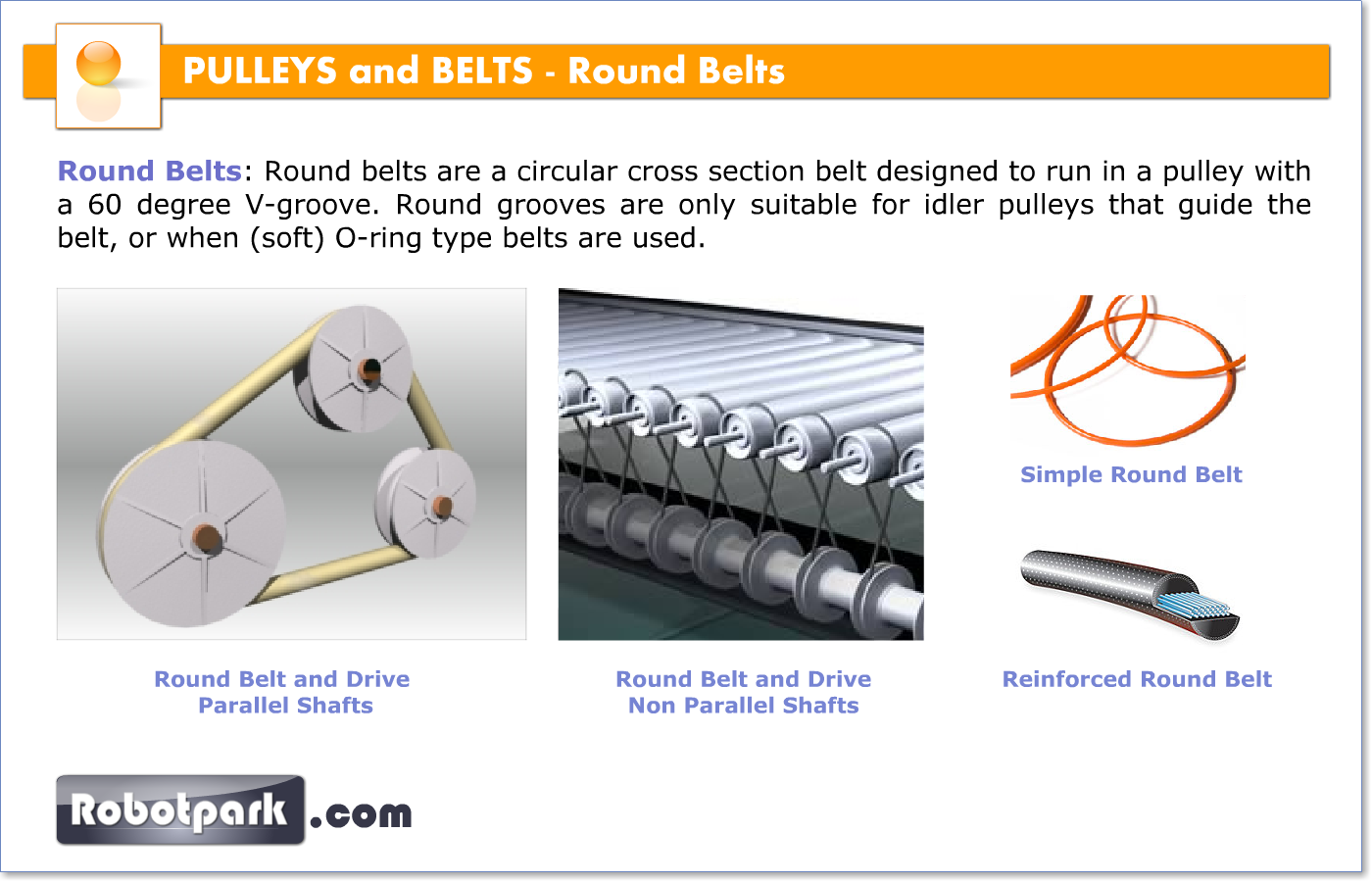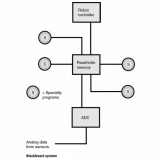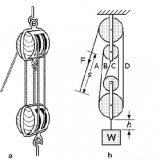Robotic Mechanisms – PULLEYS and BELTS 51045
What is a Belt ?
A belt is a loop of flexible material used to mechanically link two or more rotating shafts. Belts may be used as
-a source of motion,
-to transmit power efficiently,
-or to track relative movement.
Belts are looped over pulleys. In a two pulley system, the belt can either drive the pulleys in the same direction, or the belt may be crossed, so that the direction of the shafts is opposite. As a source of motion, a conveyor belt is one application where the belt is adapted to continuously carry a load between two points.
Pulleys and Belts transfer rotating motion from one shaft to another. Essentially, pulleys are gears without teeth that depend on the frictional forces of connecting belts, chains, ropes, or cables to transfer torque. If both pulleys have the same diameter, they will rotate at the same speed. However, if one pulley is larger than the other, mechanical advantage and velocity ratio are gained. As with gears, the velocities of pulleys are inversely proportional to their diameters. A large drive pulley driving a smaller driven pulley by means of a belt or chain is shown in Figure . The smaller pulley rotates faster than the larger pulley in the same direction as shown in Figure A. If the belt is crossed, as shown in Figure B, the smaller pulley also rotates faster than the larger pulley, but its rotation is in the opposite direction.
A familiar example of belt and pulley drive can be seen in automotive cooling fan drives. A smooth pulley connected to the engine crankshaft transfers torque to a second smooth pulley coupled to the cooling fan with a reinforced rubber endless belt. Before reliable direct-drive industrial electric motors were developed, a wide variety of industrial machines equipped with smooth pulleys of various diameters were driven by endless leather belts from an overhead driveshaft. Speed changes were achieved by switching the belt to pulleys of different diameters on the same machine.
The machines included lathes and milling machines, circular saws in sawmills, looms in textile plants, and grinding wheels in grain mills. The source of power could have been a water wheel, windmill, or a steam engine.
Pros and Cons of Belts
-Belt drive is simple, inexpensive, and does not require axially aligned shafts.
-It helps protect the machinery from overload and jam, and damps and isolates noise and vibration.
-Load fluctuations are shock-absorbed (cushioned).
-They need no lubrication and minimal maintenance.
-They have high efficiency (90-98%, usually 95%), high tolerance for misalignment, and are inexpensive if the shafts are far apart.
-Clutch action is activated by releasing belt tension.
-Different speeds can be obtained by step or tapered pulleys.
-The angular-velocity ratio may not be constant or equal to that of the pulley diameters, due to slip and stretch.
-However, this problem has been largely solved by the use of toothed belts.
-Temperatures ranges from −31 °F (−35 °C) to 185 °F (85 °C).
-Adjustment of center distance or addition of an idler pulley is crucial to compensate for wear and stretch.
TYPES OF BELTS
Flat Belts
Flat belts were widely used in the 19th and early 20th centuries in line shafting to transmit power in factories. They were also used in countless farming, mining, and logging applications, such as bucksaws, sawmills, threshers, silo blowers, conveyors for filling corn cribs or haylofts, balers, water pumps (for wells, mines, or swampy farm fields), and electrical generators. Flat belts are still used today, although not nearly as much as in the line shaft era. The flat belt is a simple system of power transmission that was well suited for its day.
It can deliver high power at high speeds (500 hp at 10,000 ft/min), in cases of wide belts and large pulleys. But these drives are bulky, requiring high tension leading to high loads, and are poorly suited to close-centers applications, so vee belts have mainly replaced flat-belts for short-distance power transmission; and longer-distance power transmission is typically no longer done with belts at all. For example, factory machines now tend to have individual electric motors.
Because flat belts tend to climb towards the higher side of the pulley, pulleys were made with a slightly convex or “crowned” surface (rather than flat) to allow the belt to self-center as it runs. Flat belts also tend to slip on the pulley face when heavy loads are applied, and many proprietary belt dressings were available that could be applied to the belts to increase friction, and so power transmission.
Flat belts were traditionally made of leather or fabric. Today some are made of rubber or polymers. Grip of leather belts is often better if they are assembled with the hair side (outer side) of the leather against the pulley, although some belts are instead given a half-twist before joining the ends (forming a Möbius strip), so that wear can be evenly distributed on both sides of the belt. Belts ends are joined by lacing the ends together with leather thonging, steel comb fasteners,or glued splices (with thonging being the oldest of the methods). Flat belts were traditionally jointed, and still usually are, but they can also be made with endless construction.
Round Belts
Round belts are a circular cross section belt designed to run in a pulley with a 60 degree V-groove. Round grooves are only suitable for idler pulleys that guide the belt, or when (soft) O-ring type belts are used. The V-groove transmits torque through a wedging action, thus increasing friction. Nevertheless, round belts are for use in relatively low torque situations only and may be purchased in various lengths or cut to length and joined, either by a staple, a metallic connector (in the case of hollow plastic), glueing or welding (in the case of polyurethane). Early sewing machines utilized a leather belt, joined either by a metal staple or glued, to great effect.
Vee Belts
Vee belts (also known as V-belt or wedge rope) solved the slippage and alignment problem. It is now the basic belt for power transmission. They provide the best combination of traction, speed of movement, load of the bearings, and long service life. They are generally endless, and their general cross-section shape is trapezoidal (hence the name “V”). The “V” shape of the belt tracks in a mating groove in the pulley (or sheave), with the result that the belt cannot slip off. The belt also tends to wedge into the groove as the load increases—the greater the load, the greater the wedging action—improving torque transmission and making the V-belt an effective solution, needing less width and tension than flat belts. V-belts trump flat belts with their small center distances and high reduction ratios. The preferred center distance is larger than the largest pulley diameter, but less than three times the sum of both pulleys. Optimal speed range is 1000–7000 ft/min. V-belts need larger pulleys for their larger thickness than flat belts.
For high-power requirements, two or more vee belts can be joined side-by-side in an arrangement called a multi-V, running on matching multi-groove sheaves. This is known as a multiple-V-belt drive (or sometimes a “classical V-belt drive”).
V-belts may be homogeneously rubber or polymer throughout, or there may be fibers embedded in the rubber or polymer for strength and reinforcement. The fibers may be of textile materials such as cotton, polyamide (such as Nylon) or polyester or, for greatest strength, of steel or aramid (such as Twaron or Kevlar).
When an endless belt does not fit the need, jointed and link V-belts may be employed. However they are weaker and only usable at speeds up to 4000 ft/min. A link v-belt is a number of rubberized fabric links held together by metal fasteners. They are length adjustable by disassembling and removing links when needed.
Multi-Groove Belts – Poly V Belts
A multi-groove or polygroove belt is made up of usually 5 or 6 “V” shapes alongside each other. This gives a thinner belt for the same drive surface, thus it is more flexible, although often wider. The added flexibility offers an improved efficiency, as less energy is wasted in the internal friction of continually bending the belt. In practice this gain of efficiency causes a reduced heating effect on the belt and a cooler-running belt lasts longer in service.
A further advantage of the polygroove belt that makes them popular is that they can run over pulleys on the ungrooved back of the belt. Though this is sometimes done with Vee belts with a single idler pulley for tensioning, a polygroove belt may be wrapped around a pulley on its back tightly enough to change its direction, or even to provide a light driving force.
Any Vee belt’s ability to drive pulleys depends on wrapping the belt around a sufficient angle of the pulley to provide grip. Where a single-Vee belt is limited to a simple convex shape, it can adequately wrap at most three or possibly four pulleys, so can drive at most three accessories. Where more must be driven, such as for modern cars with power steering and air conditioning, multiple belts are required. As the polygroove belt can be bent into concave paths by external idlers, it can wrap any number of driven pulleys, limited only by the power capacity of the belt.
This ability to bend the belt at the designer’s whim allows it to take a complex or “serpentine” path. This can assist the design of a compact engine layout, where the accessories are mounted more closely to the engine block and without the need to provide movable tensioning adjustments. The entire belt may be tensioned by a single idler pulley.
Ribbed Belt
A ribbed belt is a power transmission belt featuring lengthwise grooves. It operates from contact between the ribs of the belt and the grooves in the pulley. Its single-piece structure is reported to offer an even distribution of tension across the width of the pulley where the belt is in contact, a power range up to 600 kW, a high speed ratio, serpentine drives (possibility to drive off the back of the belt), long life, stability and homogeneity of the drive tension, and reduced vibration. The ribbed belt may be fitted on various applications : compressors, fitness bikes, agricultural machinery, food mixers, washing machines, lawn mowers, etc.
Timing Belts (Toothed Belts)
Timing belts, (also known as toothed, notch, cog, or synchronous belts) are a positive transfer belt and can track relative movement. These belts have teeth that fit into a matching toothed pulley. When correctly tensioned, they have no slippage, run at constant speed, and are often used to transfer direct motion for indexing or timing purposes (hence their name). They are often used in lieu of chains or gears, so there is less noise and a lubrication bath is not necessary. Camshafts of automobiles, miniature timing systems, and stepper motors often utilize these belts. Timing belts need the least tension of all belts, and are among the most efficient. They can bear up to 200 hp (150 kW) at speeds of 16,000 ft/min.
Timing belts with a helical offset tooth design are available. The helical offset tooth design forms a chevron pattern and causes the teeth to engage progressively. The chevron pattern design is self-aligning. The chevron pattern design does not make the noise that some timing belts make at certain speeds, and is more efficient at transferring power (up to 98%).
Disadvantages include a relatively high purchase cost, the need for specially fabricated toothed pulleys, less protection from overloading and jamming, and the lack of clutch action.
Belts and Applications
Related Terms
Alignment: In a belt drive system, the arrangement of pulleys or the shafts on which the pulleys are mounted. Proper alignment is necessary for effective power transmission.
Asperities: Microscopic peaks found on all surfaces. Contact between asperities on different surfaces causes friction.
Backing: The material that surrounds the tensile member of a synchronous belt. The backing is generally made of neoprene.
Backlash: The distance that a synchronous belt will move while meshing with a pulley that is not moving.
Bearing: A friction-reducing device that allows one moving part to glide past another moving part.
Belt: A band of flexible material that is looped around two or more fixed pulleys to transmit motion. Belts are made of various materials and come in different types, such as flat belts, round belts, and V-belts.
Belt Drive System: A mechanical system consisting of a flexible belt and at least two fixed pulleys that is used to transmit motion. Belt drive systems are low maintenance and do not require lubrication.
Belt Friction : Belt drives depend on friction to operate, but excessive friction wastes energy and rapidly wears the belt. Factors that affect belt friction include belt tension, contact angle, and the materials used to make the belt and pulleys.
Belt Joint: A device used to join a flat belt into an endless loop. Common types of belt joints include lacing and hooks.
Belt Span: The distance on a belt from the center of the shaft on one pulley to the center of the shaft on the other pulley.
Belt Tension: Power transmission is a function of belt tension. However, also increasing with tension is stress (load) on the belt and bearings. The ideal belt is that of the lowest tension that does not slip in high loads. Belt tensions should also be adjusted to belt type, size, speed, and pulley diameters. Belt tension is determined by measuring the force to deflect the belt a given distance per inch of pulley. Timing belts need only adequate tension to keep the belt in contact with the pulley.
Belt Tension Tester: A device used to check the tension of a belt drive system.
Belt Wear: Fatigue, more so than abrasion, is the culprit for most belt problems. This wear is caused by stress from rolling around the pulleys. High belt tension; excessive slippage; adverse environmental conditions; and belt overloads caused by shock, vibration, or belt slapping all contribute to belt fatigue.
Centimeters Per Minute: A metric unit used to measure the speed of a belt drive. Centimeters per minute is abbreviated as cpm.
Chain Drive System: A system consisting of a chain and sprockets that is used to transmit motion.
Classical V-Belt: A type of V-belt designed for heavy-duty applications, which can be used together with other belts to transmit power. Classical V-belts are also known as multiple V-belts.
Cogged V-Belt: A type of V-belt that is notched on its underside to allow the belt to flex more easily. Certain types of cogged V-belts offer quieter operation than other types of V-belts.
Compression Section: The part of a V-belt that supports the tension section. The compression section is generally made of rubber or rubberized fabric.
Conveyor Belt: A belt used in industry to transport materials over a distance.
Creep: A condition that occurs in flat belt drives that causes the belt to move forward slightly on the driving pulley, which causes the driven pulley to rotate at a slower speed.
Cross-Section: The section width of a V-belt that is used to indicate the size of the belt. V-belt cross-sections are measured in height and width.
Driven Pulley: The fixed pulley in a belt drive system that receives energy from the driver pulley via the belt.
Driver Pulley: The fixed pulley in a belt drive system that receives energy from the power source and transfers it to the driven pulley via the belt.
Efficiency: A measure of the work output of a system versus the total energy input. An efficient system is able to convert a greater amount of the supplied energy into the intended useful work.
Electric Motor: A machine that converts electricity into mechanical energy or motion. An electric motor is a common power source for a mechanical system.
Endless Belt: A belt that has been joined in a loop. Belts that are not manufactured as endless can be joined with a belt joint.
Facing: A tough fabric, generally nylon, used to cover a synchronous belt and protect tooth surfaces.
Feet Per Minute: A unit used to measure the speed of a belt drive. Feet per minute is abbreviated as fpm.
Fiberglass: A lightweight, strong material composed of fine glass fibers. Fiberglass cords are often used in synchronous belts.
Fixed Pulley: A device consisting of a wheel rigidly fixed to a shaft that is used in a belt drive system to transmit motion.
Flat Belt: A belt consisting of a flat loop of material used to transmit motion between two pulleys. Flat belts can be made of various materials, such as rubber, canvas, plastic, or flexible metals.
Force Scale: The scale on a belt tension tester that marks the tension of the belt.
Fractional Horsepower: A horsepower rating less than 1 hp.
Fractional Horsepower V-Belt: A type of V-belt that can be used for light-duty applications, such as those that transmit less than 1 hp.
Friction: The resistance to relative motion between surfaces. Friction is caused by contact between surface asperities.
Gear: A round or cylindrical mechanical component with teeth that is used to transmit power. Gears are designed to mesh with one another and can alter the speed, torque, or direction of mechanical energy.
Hook: A type of belt joint that uses metal fasteners that are implanted in the belt.
Horsepower: A unit of power used to describe machine strength. One horsepower equals 33,000 ft-lbs of work per minute, or 746 watts.
Joined V-Belt: A type of V-belt that includes mutiple V-belts joined together on the top to provide smoother operation. Joined V-belts can be used in classical V-belt drives.
Lacing: A type of belt joint often used with leather belting in which the ends of the belt are stitched together.
Lockout/Tagout: A method of protecting employees from accidental machine startup through proper locking and labeling of machines that are undergoing maintenance.
Lubrication: The application of a substance to reduce friction between two surfaces in relative motion. Oil and grease are commonly used for lubrication.
Machine Guard: A shield or cover over hazardous areas on a machine to prevent accidental contact with body parts or to prevent debris, such as chips, from exiting the machine.
Misalignment: A condition in a belt drive system when pulleys or their shafts are not arranged properly. Both shaft and pulley misalignment can damage belt drives.
Multiple V-Belt: A type of V-belt designed for heavy-duty applications, which can be used together with other belts to transmit power. Multiple V-belts are also known as classical V-belts.
Narrow V-Belt: A type of V-belt that can transmit more horsepower than a classical V-belt, though it is narrower in design. Narrow V-belts are also known as wedge V-belts.
Neoprene: A lightweight synthetic material, similar to rubber, that is often used as backing for synchronous belts.
Nylon: A strong, elastic synthetic material often used as facing in synchronous belts.
O-Ring: A small rubber ring used on a belt tension tester to mark readings of belt span and belt tension.
Overtension: A condition in which a belt drive is operating under excess tension. The damaging effects of overtension include wear of belts and pulleys and permanent stretching of the belt.
Pitch: On a synchronous belt, the distance between the centers of two belt teeth or two grooves in the belt.
Premium Multiple V-Belt: A type of classical V-belt used with V-belt drives that operate under severe or shock loads or are subject to extreme temperatures or vibration.
Serpentine Belt System: A belt drive system that includes more than two fixed pulleys working in conjunction.
Shock Load: A sudden and intense force placed on machine components.
Single V-Belt: A type of V-belt that can be used for light-duty applications, such as those that transmit less than 1 hp. Single V-belts are also known as fractional horsepower V-belts.
Slip: A condition that occurs in flat belt drives when the load causes the belt to slide out of proper position on the pulley.
Sprocket: A wheel with metal teeth that meshes with the links of a chain. Sprockets are used in chain drive systems to transmit motion.
Standard Multiple V-Belt: A type of classical V-belt suitable for most V-belt drives that operate under normal loads.
Straight Edge: A flat, rectangular hand tool that can be used to draw straight lines or determine the straightness of a line.
Synchronous Belt: A toothed belt, also known as a timing belt, that meshes with the grooves of a pulley in a synchronous belt drive. Synchronous belts maintain constant speed during power transmission, and they do not slip.
Synchronous Belt Drive: A type of belt drive in which the teeth of a synchronous belt mesh with the grooves in a pulley to transmit power.
Tensile Member: The part of a synchronous belt that supports the load. The tensile member consists of cords and is surrounded by the backing.
Tension: A pulling force that is directed away from the object and attempts to move, stretch, or elongate the object. Belt drive systems must operate under proper tension to transfer power effectively.
Tension Section: The part of a V-belt that supports the load. The tension section contains synthetic fibers surrounded by a rubber coating.
Timing Belt: A toothed belt, also known as a synchronous belt, that meshes with the grooves of a pulley in a synchronous belt drive. Timing belts maintain constant speed during power transmission, and they do not slip.
Undertension: A condition in which a belt drive is operating under too little tension. The damaging effects of undertension include loss of efficiency and belt slippage.
V-Belt: A belt with a flat bottom and tapered sides that transmits motion between two pulleys. Multiple V-belts are often used together in order to increase carrying power.
V-Belt Pulley: A pulley designed with one or more grooves, allowing a V-belt to wedge into each groove for power transmission.
V-Ribbed Belt: A type of V-belt that combines elements of a flat belt and a classical V-belt. The V-ribbed belt resembles a flat belt on top with V-shaped ribs on the bottom.
Wedge V-Belt: A type of V-belt that can transmit more horsepower than a classical V-belt, though it is narrower in design. Wedge V-belts are also known as narrow V-belts.












